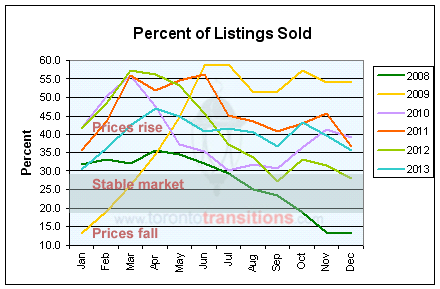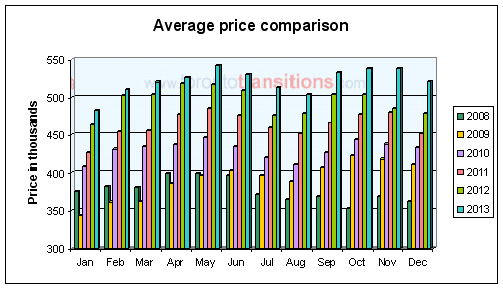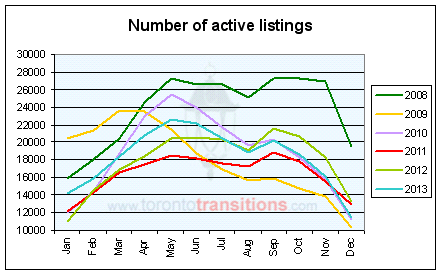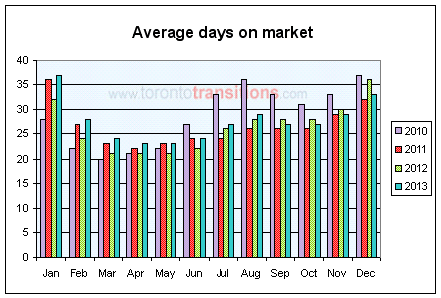December 2013 Toronto Real Estate Statistics
Despite poor weather conditions,
Greater Toronto Area
experienced an unusually busy December. In comparison to the same time last year, 13.8% more listings were sold, with 3.9% fewer new listings, and 13.8% fewer available listings at the end of the month. Properties were selling almost as fast as new listings became available: we had 4102 new listings and 4078 sales.
In the
City of Toronto,
tight supply of detached homes resulted in
detached house sales decrease by 6.7%. The largest increase in the number of sales, 20.7%, was recorded for condo apartments. There was an 8.8% increase in sales of semi-detached homes, and 13.2% increase in townhouse sales. All these were calculated in comparison to December 2012.
Mortgage rates remain affordable, despite recent increases, and they are expected to remain affordable in 2014 as well.
Average price of detached residences in the
City of Toronto
was $864,351 (up 18.9%), of semi-detached - $644,423 (up 15.9%), of townhouses - $447,188 (up 13.4%), and of condos - $367,376 (up 7.6%).
Average time required to sell a detached house in December in the City of Toronto was 28 days, semi-detached homes required 21 days of market exposure, and condos 39 days.
Average ratio of selling to listing price in the City if Toronto for detached houses was 97%, for semi-detached was 101%, and for condos 97%.
In Historical Perspective:
The factors listed below influence real estate sales and property prices:
-
Buyers have adjusted to the stricter mortgage lending guidelines, and, seeing no downturn in the house values, are returning to the market.
-
Despite recent increases in the interest rates, we still expect them to remain low through 2014. It is harder to get a mortgage with the new lending guidelines, but borrowing for home purchase still remains affordable.
-
Real estate market is driven by supply and demand. With a tight supply, especially in a low-rise segment of the market, the buyers are competing for existing listings, and the prices are strong.
-
Employment levels are gradually improving, although unemployment numbers are still fairly high. Immigration levels remain steady, and inflation is low.
We encourage you to view
video presentations by Jason Mercer
, TREB senior manager of market analysis.
Interestings stats on sales of freehold homes in the City of Toronto:

The following graphs illustrate the performance of Toronto real estate market since 2008:

Thie graph above illustrates the main attribute of a real estate market - the relation, in percent, between listings sold each month and all available listings at the end of that month. A typical stable market, with buyers able to negotiate purchase prices, but, at the same time sellers able to sell their homes or condos, is when the proportion of sold to available listings is between 18% and 28%.
When that proportion is lower than 18%, prices fall, and the situation is referred to as a "buyers' market". When it is more than 28%, prices rise, and we have a "seller's market". After dipping twice in 2012 into the "stable market" territory, the proportion in December 2013 was 35.7% - well in the "sellers' market". That proportion is following a typical yearly trend, dipping in September a bit, mostly due to a good number of new listings reaching the market after the labour day weekend.

As you can see on this graph, Toronto real estate prices follow the typical yearly trend. Average prices change with the general real estate price trend, but depend on the type of properties selling at any given time. Unusual changes in the typical seasonal trend may reflect a changing market conditions.
2012 ended with the average prices 6.8% higher than the previous year. By the end of 2013 the average year-over-year price increase was 5.2%.

It is typical for the number of MLS listings to start low at the beginning of the year, as few sellers opt to market their property over the holidays. In February and March more listings become available, with the number of available litings usually peaking in May, to decrease over the summer months, rise again in September, and fall in November - December.
While the volume of listings changes seasonally and generally follows a typical trend, the higher it goes, the less pressure there is on the real estate prices.

Since the beginning of 2011, real estate listings in Toronto were selling, on average, within one month. If a property takes longer than the average to sell, the reason is either too high a listing price, poor condition of the house, or inadequete access for showing it. In December in the GTA homes were selling, on average, in 33 days. Within the City limits, the average time on the market for all types of properties was also 33 days, detached homes took 28 days, on average, semi-detached required only 21 days, condominium townhouses took 27 days, and condo apartments - 39 days.
Following tables illustrate sales of freehold homes (not including condo apartments and condo townhouses) in Toronto since the beginning of 2013:
In January:
|
Area
|
number of sales
|
100% of list
|
over 100% of list
|
% of homes sold over asking
|
|
Central
|
237
|
19
|
54
|
22.8%
|
|
East
|
313
|
31
|
69
|
22.0%
|
|
West
|
234
|
24
|
49
|
20.9%
|
In February:
|
Area
|
number of sales
|
100% of list
|
over 100% of list
|
% of homes sold over asking
|
|
Central
|
383
|
52
|
100
|
26.1%
|
|
East
|
432
|
57
|
119
|
27.5%
|
|
West
|
315
|
38
|
86
|
27.3%
|
In March:
|
Area
|
number of sales
|
100% of list
|
over 100% of list
|
% of homes sold over asking
|
|
Central
|
471
|
50
|
134
|
28.4%
|
|
East
|
563
|
82
|
188
|
33.4%
|
|
West
|
451
|
50
|
154
|
34.1%
|
In April:
|
Area
|
number of sales
|
100% of list
|
over 100% of list
|
% of homes sold over asking
|
|
Central
|
606
|
54
|
231
|
38.1%
|
|
East
|
744
|
89
|
305
|
41.0%
|
|
West
|
559
|
68
|
173
|
30.9%
|
In May:
|
Area
|
number of sales
|
100% of list
|
over 100% of list
|
% of homes sold over asking
|
|
Central
|
655
|
64
|
212
|
32.4%
|
|
East
|
760
|
95
|
297
|
39.1%
|
|
West
|
665
|
57
|
241
|
36.2%
|
In June:
|
Area
|
number of sales
|
100% of list
|
over 100% of list
|
% of homes sold over asking
|
|
Central
|
506
|
43
|
170
|
33.6%
|
|
East
|
682
|
75
|
250
|
36.7%
|
|
West
|
545
|
72
|
167
|
30.6%
|
In July:
|
Area
|
number of sales
|
100% of list
|
over 100% of list
|
% of homes sold over asking
|
|
Central
|
384
|
25
|
104
|
27.1%
|
|
East
|
590
|
77
|
181
|
30.7%
|
|
West
|
466
|
53
|
110
|
23.6%
|
In August:
|
Area
|
number of sales
|
100% of list
|
over 100% of list
|
% of homes sold over asking
|
|
Central
|
311
|
21
|
80
|
25.7%
|
|
East
|
527
|
52
|
167
|
31.7%
|
|
West
|
381
|
46
|
79
|
20.7%
|
In September:
|
Area
|
number of sales
|
100% of list
|
over 100% of list
|
% of homes sold over asking
|
|
Central
|
438
|
43
|
159
|
36.3%
|
|
East
|
570
|
68
|
214
|
37.5%
|
|
West
|
463
|
50
|
132
|
28.5%
|
In October:
|
Area
|
number of sales
|
100% of list
|
over 100% of list
|
% of homes sold over asking
|
|
Central
|
531
|
67
|
163
|
30.7%
|
|
East
|
629
|
61
|
222
|
35.3%
|
|
West
|
496
|
55
|
142
|
28.6%
|
In November:
|
Area
|
number of sales
|
100% of list
|
over 100% of list
|
% of homes sold over asking
|
|
Central
|
411
|
33
|
132
|
32.1%
|
|
East
|
503
|
60
|
183
|
36.4%
|
|
West
|
393
|
34
|
112
|
28.5%
|
In December:
|
Area
|
number of sales
|
100% of list
|
over100% of list
|
% of homes sold over asking
|
|
Central
|
166
|
8
|
47
|
28.3%
|
|
East
|
253
|
23
|
74
|
29.2%
|
|
West
|
215
|
20
|
54
|
25.1%
|
If you are interested in statistics from a particular neighbourhood or street, please call or e-mail us, and we will be happy to prepare the information for you.
For information on real estate conditions in Toronto in 2010, please visit our
2010 report
. Please visit our
2012 Market Conditions
and
2011 Market Conditions
page for comparison.


